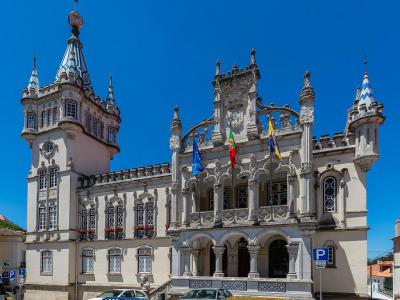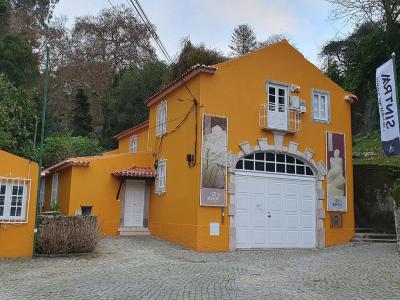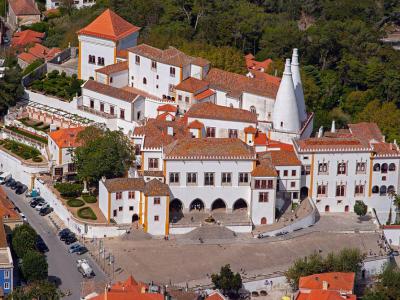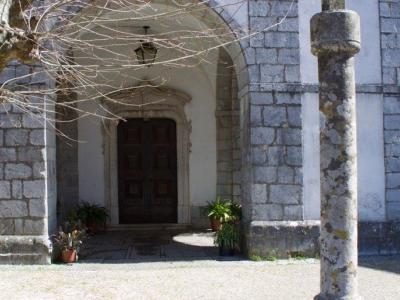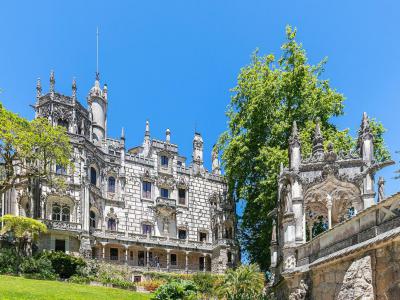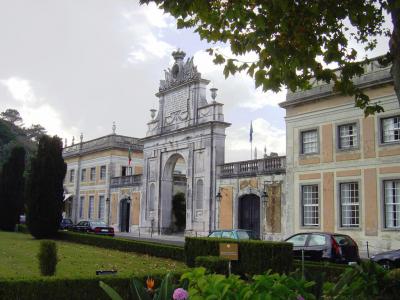Sintra Introduction Walking Tour (Self Guided), Sintra
Traces of humanity in Sintra date back to Paleolithic times. At an open air site near the church of Sao Pedro de Canaferrim and the Moorish Castle there were found ceramics from 5,000 BC. The name Sintra is indo-European. It means "bright star" or "sun." Romans called the place "sacred mountain." Ptolemy called it "mountains of the moon."
In 1147 the Moorish Castle (Castelo dos Mouros) surrendered to Afonso Henriques. Afonso commenced building Christian churches. The church of Saint Peter of Canaferrim was established within the walls of the Castle. Throughout the 12th and 13th centuries convents, monasteries, and the military built residences, estates and mills.
In 1287 King Dinis ceded the town to Queen Elizabeth of Portugal. The town remained a possession of the Queen of Portugal until 1383. King Edward described the region in 1435 as "A land of good air and water." Sintra has been the refuge of kings and nobility for centuries. It is replete with locations that are enigmatic and magical.
The Pena Palace is for fans of Romantic architecture and sprawling exotic gardens. The Regaleira Palace sits amid an enchanted wood and gardens filled with statues of mythological heroes and ceremonial wells for obscure rites. Wells with stairs but no water.
The Tivoli Palace Seteais is a five-star hotel in a former palace on a hill with gardens and fruit trees. The Sintra National Palace is genuinely medieval, unaltered for 900 years with enormous twin chimneys. The Moorish Castle sits above the National Palace with breathtaking views.
Sintra is the Riviera of Portugal. A haven for kings, saints and travelers. Famous for its palaces, castles, churches, gardens, beaches and parks. It has been called the best place to live in Portugal and has been classified a UNESCO World Heritage Site. Why did Europeans and Moors fought so hard for this pleasant piece of land? Come and see.
In 1147 the Moorish Castle (Castelo dos Mouros) surrendered to Afonso Henriques. Afonso commenced building Christian churches. The church of Saint Peter of Canaferrim was established within the walls of the Castle. Throughout the 12th and 13th centuries convents, monasteries, and the military built residences, estates and mills.
In 1287 King Dinis ceded the town to Queen Elizabeth of Portugal. The town remained a possession of the Queen of Portugal until 1383. King Edward described the region in 1435 as "A land of good air and water." Sintra has been the refuge of kings and nobility for centuries. It is replete with locations that are enigmatic and magical.
The Pena Palace is for fans of Romantic architecture and sprawling exotic gardens. The Regaleira Palace sits amid an enchanted wood and gardens filled with statues of mythological heroes and ceremonial wells for obscure rites. Wells with stairs but no water.
The Tivoli Palace Seteais is a five-star hotel in a former palace on a hill with gardens and fruit trees. The Sintra National Palace is genuinely medieval, unaltered for 900 years with enormous twin chimneys. The Moorish Castle sits above the National Palace with breathtaking views.
Sintra is the Riviera of Portugal. A haven for kings, saints and travelers. Famous for its palaces, castles, churches, gardens, beaches and parks. It has been called the best place to live in Portugal and has been classified a UNESCO World Heritage Site. Why did Europeans and Moors fought so hard for this pleasant piece of land? Come and see.
How it works: Download the app "GPSmyCity: Walks in 1K+ Cities" from Apple App Store or Google Play Store to your mobile phone or tablet. The app turns your mobile device into a personal tour guide and its built-in GPS navigation functions guide you from one tour stop to next. The app works offline, so no data plan is needed when traveling abroad.
Sintra Introduction Walking Tour Map
Guide Name: Sintra Introduction Walking Tour
Guide Location: Portugal » Sintra (See other walking tours in Sintra)
Guide Type: Self-guided Walking Tour (Sightseeing)
# of Attractions: 6
Tour Duration: 1 Hour(s)
Travel Distance: 2.0 Km or 1.2 Miles
Author: ellen
Sight(s) Featured in This Guide:
Guide Location: Portugal » Sintra (See other walking tours in Sintra)
Guide Type: Self-guided Walking Tour (Sightseeing)
# of Attractions: 6
Tour Duration: 1 Hour(s)
Travel Distance: 2.0 Km or 1.2 Miles
Author: ellen
Sight(s) Featured in This Guide:
- Câmara Municipal (Town Hall)
- Museum of Anjos Teixeira
- National Palace and Museum
- Igreja de S. Martinho (St. Martinho Church)
- Quinta da Regaleira (Regaleira Palace)
- Palacio Seteais (Seteais Palace)
1) Câmara Municipal (Town Hall)
Arnaldo Bermudes was among the most memorable of Portugal's greatest architects. He designed the extravagant Manueline Gothic Sintra Town Hall, built in 1910. After one look at this extraordinary flamboyant building erected over the bones of the old Chapel of Sao Sebastiao one is tempted to say, "Disneyland, eat your heart out."
The enormous clock tower and spire challenge the sky line. Even the National Palace is not more impressive. The spire has glazed reflective tiles picked out in gold, white and green, with emblems from the Portuguese coat-of-arms. Atop the spire is an armillary sphere. At the four corners of the crenelated tower are smaller spires, similarly tiled.
The architecture of the Town Hall is taken generally from many of the drawings of Arnaldo Bermudes. The overall style is neo-Manueline, reflecting Revivalist Historicist elements. The facade is a bit austere with arched neo-Manueline windows and a veranda with arches and a pediment of the city arms.
The inside holds a lush renaissance cloister with narrow upper balconies. Sad to say, the Town Hall is not normally open to tourists, but what a sight to see.
The enormous clock tower and spire challenge the sky line. Even the National Palace is not more impressive. The spire has glazed reflective tiles picked out in gold, white and green, with emblems from the Portuguese coat-of-arms. Atop the spire is an armillary sphere. At the four corners of the crenelated tower are smaller spires, similarly tiled.
The architecture of the Town Hall is taken generally from many of the drawings of Arnaldo Bermudes. The overall style is neo-Manueline, reflecting Revivalist Historicist elements. The facade is a bit austere with arched neo-Manueline windows and a veranda with arches and a pediment of the city arms.
The inside holds a lush renaissance cloister with narrow upper balconies. Sad to say, the Town Hall is not normally open to tourists, but what a sight to see.
2) Museum of Anjos Teixeira
The Museum of Anjos Teixeira, nestled in an early 20th-century watermill in Sintra’s Azinhaga da Sardinha, offers a deep dive into the artistic legacy of two generations of Portuguese sculptors-Artur Gaspar and Pedro Augusto dos Anjos Teixeira. This unique museum showcases their sculptural journey, spanning Naturalist, Realist, Late-Naturalist, and Neorealist styles.
Master Pedro Augusto dos Anjos Teixeira, renowned for his connection to the neorealism of the 1940s, officially donated much of his work, along with many pieces by his father, to the Sintra City Council in 1974. Two years later, Pedro's residence became a House Museum, serving as a public gallery and a live-in atelier where he taught sculpture until 1992. Today, the museum reflects their shared dedication to exploring themes of anatomy, freedom, labor, femininity, and historical and religious figures.
Inside, visitors can admire an array of sculptures, from Pedro’s Rodin-like depictions of feminine beauty to grand pastoral pieces portraying the rural hardships of Portugal. The museum underwent a thoughtful redesign, with lighter tones applied to walls and pedestals to highlight the displayed works better.
Accessible via steps opposite Parque da Liberdade, the museum’s location also connects to Sintra’s scenic Volta do Duche path, adorned with public sculptures by the Teixeira duo. Admission is free, and the museum offers guided tours, workshops, and classes, making it an enriching cultural stop for all ages.
Master Pedro Augusto dos Anjos Teixeira, renowned for his connection to the neorealism of the 1940s, officially donated much of his work, along with many pieces by his father, to the Sintra City Council in 1974. Two years later, Pedro's residence became a House Museum, serving as a public gallery and a live-in atelier where he taught sculpture until 1992. Today, the museum reflects their shared dedication to exploring themes of anatomy, freedom, labor, femininity, and historical and religious figures.
Inside, visitors can admire an array of sculptures, from Pedro’s Rodin-like depictions of feminine beauty to grand pastoral pieces portraying the rural hardships of Portugal. The museum underwent a thoughtful redesign, with lighter tones applied to walls and pedestals to highlight the displayed works better.
Accessible via steps opposite Parque da Liberdade, the museum’s location also connects to Sintra’s scenic Volta do Duche path, adorned with public sculptures by the Teixeira duo. Admission is free, and the museum offers guided tours, workshops, and classes, making it an enriching cultural stop for all ages.
3) National Palace and Museum (must see)
Of all the palaces in Portugal, only one spans the whole history of the country: the National Palace of Sintra. The earliest date of construction is not clear but it is probably in the 10th or 11th century when the country was still under Moorish control. The palace is actually a complex of buildings adapted and added to over time.
The palace is known to have the most extensive collection of Mudéjar artifacts and Azulejo tiles in the world. Long after the reconquest of Sintra by Afonso Henriques in 1139, King Dinis proclaimed in 1281 that the maintenance of the palace should be the responsibility of the enfranchised Moors residing there.
In 1415 King John I constructed the main body of the palace complex around the central courtyard, called John's Wing. The facade of the main building has entrance arches and mullioned bifora windows in Manueline and Mudejar styles. The building has twin giant conical chimneys towering above enormous medieval kitchens.
Besides the circus-sized kitchens, King John I installed several rooms. The Swan Room has swans painted on the ceiling, celebrating the marriage of Philip the Good of Burgundy to his third wife, Isabela of Portugal.
The Magpie room has dozens of magpies painted on the ceiling and the frieze. The birds carry the message "For Good" in their beaks. The number of Magpies equaled the number of ladies of the court. The ladies had been gossiping about John stealing a kiss from a lady-in-waiting. He got his revenge by having the gossipers painted as chattering magpies.
Other rooms, from the reign of King Manuel I, include the Coat of Arms Room in the Manuel's Wing. The room has a coffered wooden ceiling with the coats of arms of 72 noble families of Portugal. The Golden Chamber was a receiving room for royalty. The Grotto of the Baths is covered in tile pictures of the Creation.
The palace was declared a National Monument in 1910 and a World Heritage Site by UNESCO in 1995.
The palace is known to have the most extensive collection of Mudéjar artifacts and Azulejo tiles in the world. Long after the reconquest of Sintra by Afonso Henriques in 1139, King Dinis proclaimed in 1281 that the maintenance of the palace should be the responsibility of the enfranchised Moors residing there.
In 1415 King John I constructed the main body of the palace complex around the central courtyard, called John's Wing. The facade of the main building has entrance arches and mullioned bifora windows in Manueline and Mudejar styles. The building has twin giant conical chimneys towering above enormous medieval kitchens.
Besides the circus-sized kitchens, King John I installed several rooms. The Swan Room has swans painted on the ceiling, celebrating the marriage of Philip the Good of Burgundy to his third wife, Isabela of Portugal.
The Magpie room has dozens of magpies painted on the ceiling and the frieze. The birds carry the message "For Good" in their beaks. The number of Magpies equaled the number of ladies of the court. The ladies had been gossiping about John stealing a kiss from a lady-in-waiting. He got his revenge by having the gossipers painted as chattering magpies.
Other rooms, from the reign of King Manuel I, include the Coat of Arms Room in the Manuel's Wing. The room has a coffered wooden ceiling with the coats of arms of 72 noble families of Portugal. The Golden Chamber was a receiving room for royalty. The Grotto of the Baths is covered in tile pictures of the Creation.
The palace was declared a National Monument in 1910 and a World Heritage Site by UNESCO in 1995.
4) Igreja de S. Martinho (St. Martinho Church)
In 1147, King Afonso Henriques conquered Sintra. He ordered the construction of at least four Christian churches near the newly captured palace. In 1241, mainly because of the church's proximity to the palace, the Saint Martinho Church was granted the status of Cathedral.
Ironically, the church prospered during the the time of the bubonic plague. Rich citizens who died willed their wealth to the church. King Manuel himself had willed personal funds for the maintenance of Saint Martin's Church.
In the devastating Lisbon earthquake of 1755. The roof collapsed. The church remained in ruins until the king, Joseph I, grew tired of seeing it on his way to the palace. He urged the prime minister, the Marquis de Pombal, to restore it. Pombal hired architect Mateus Vicente de Oliveira for the job.
The restored church is a single vessel building with an oversized square bell tower. The tower is in two sections. The lower section has clocks and the upper section has a carillon behind four arched portals. The top of the tower has spires at each corner and a small dome and spire in the center.
The interior is a single nave with a vaulted ceiling. The ceiling is painted to give the illusion of marble and stucco designs. The arch over the altar is decorated with paintings of the Passion of Christ by Sintra artist Diogo de Contreiras. The altar is Baroque. It has gilded sculptures in niches and statues of Saints Martin and Anthony.
Ironically, the church prospered during the the time of the bubonic plague. Rich citizens who died willed their wealth to the church. King Manuel himself had willed personal funds for the maintenance of Saint Martin's Church.
In the devastating Lisbon earthquake of 1755. The roof collapsed. The church remained in ruins until the king, Joseph I, grew tired of seeing it on his way to the palace. He urged the prime minister, the Marquis de Pombal, to restore it. Pombal hired architect Mateus Vicente de Oliveira for the job.
The restored church is a single vessel building with an oversized square bell tower. The tower is in two sections. The lower section has clocks and the upper section has a carillon behind four arched portals. The top of the tower has spires at each corner and a small dome and spire in the center.
The interior is a single nave with a vaulted ceiling. The ceiling is painted to give the illusion of marble and stucco designs. The arch over the altar is decorated with paintings of the Passion of Christ by Sintra artist Diogo de Contreiras. The altar is Baroque. It has gilded sculptures in niches and statues of Saints Martin and Anthony.
5) Quinta da Regaleira (Regaleira Palace) (must see)
The word "Quinta" refers to a whole estate and all within it. In this Quinta there are many wonders and curiosities in the palace itself and in the mysterious lakes, woods, grottoes, wells and constructions surrounding it.
The palace is known locally as "The Palace of Monteiro the Millionaire." The "Millionaire" is the former owner, Antonio Monteiro and he was, allegorically, an "eccentric" millionaire.
Quinta da Regaleira had belonged to D. Emelinda Monteiro de Almeida, Viscountess of Regaleira, child of a wealthy family of Porto. Emelinda sold the estate to Monteiro in 1892. Antonio was a millionaire coffee merchant from Brazil. He had obsessions that he needed to explore.
He hired Italian architect Luigi Manini and they set to work. They created various enigmatic buildings and settings derived from alchemy, Free Masonry, the Knights Templar, and even the Rosicrucians.
Construction started in 1904. It was mostly complete by 1910. The Palace facade is lavishly decorated with Gothic pinnacles, gargoyles, capitals and an awesome octagonal tower. The palace building has five floors; a ground floor, three upper floors and a basement. The uppermost floor opens on to a terrace.
A chapel is in front of the palace facade. There are frescoes, stained glass windows, stuccos, an armillary sphere and more than a few pentagrams. Most of the estate is wooded with park land and wild wood. There is a system of tunnels that connect to grottos, the chapel, lakes, caves, the tower and the awesome "Initiation Wells."
The Initiation Wells were meant as inverted towers for secret rites including the Tarot, Masons, Rosicrucians and all the rest of it. Spiral stairs lead to the bottom and tunnels connect to other sites on the estate. Sounds like spooky fun.
Lastly there are the lakes, fountains and the aquarium, not stocked with anything. The palace was designated a World Heritage site by UNESCO in 1995.
The palace is known locally as "The Palace of Monteiro the Millionaire." The "Millionaire" is the former owner, Antonio Monteiro and he was, allegorically, an "eccentric" millionaire.
Quinta da Regaleira had belonged to D. Emelinda Monteiro de Almeida, Viscountess of Regaleira, child of a wealthy family of Porto. Emelinda sold the estate to Monteiro in 1892. Antonio was a millionaire coffee merchant from Brazil. He had obsessions that he needed to explore.
He hired Italian architect Luigi Manini and they set to work. They created various enigmatic buildings and settings derived from alchemy, Free Masonry, the Knights Templar, and even the Rosicrucians.
Construction started in 1904. It was mostly complete by 1910. The Palace facade is lavishly decorated with Gothic pinnacles, gargoyles, capitals and an awesome octagonal tower. The palace building has five floors; a ground floor, three upper floors and a basement. The uppermost floor opens on to a terrace.
A chapel is in front of the palace facade. There are frescoes, stained glass windows, stuccos, an armillary sphere and more than a few pentagrams. Most of the estate is wooded with park land and wild wood. There is a system of tunnels that connect to grottos, the chapel, lakes, caves, the tower and the awesome "Initiation Wells."
The Initiation Wells were meant as inverted towers for secret rites including the Tarot, Masons, Rosicrucians and all the rest of it. Spiral stairs lead to the bottom and tunnels connect to other sites on the estate. Sounds like spooky fun.
Lastly there are the lakes, fountains and the aquarium, not stocked with anything. The palace was designated a World Heritage site by UNESCO in 1995.
6) Palacio Seteais (Seteais Palace) (must see)
In the late 18th century, Daniel Gildemeester, the Dutch consul in Sintra, was a tenant of Portuguese Prime Minister, Sebastião Mello, Marquis of Pombal. Daniel wanted a mansion of his own. He chose land on a hill with great views and fruit trees. He hired neoclassical architect Jose da Costa e Silva and built the Seteais Palace.
There are several derivations given for the name "Seteais." An old manuscript in the Sintra library says the word Seteais is from land called "Centeais", land growing rye, "Centeio" in Portuguese. In 1797 Daniel's widow sold the palace to Diogo Coutinho, 5th Marquis of Marialva.
Diogo used architect Jose again to expand the palace in 1802. It became a U-shaped building. The former consul's house was now one of the wings. The cornices of the facade were adorned with busts and garlands and other neoclassical motifs. The two wings were connected by a neoclassical arch honoring John VI and Princess Carlota Joaquina.
The arch honoring the royal couple was designed by architect Francisco Real Garcia. The walls and some rooms had frescoes of rare vegetation and mythical figures by French painter Jean Pillement. The State of Portugal acquired the palace and estate lands in 1946. It was remade in 1954 as the luxury hotel Tivoli Palacio de Seteais.
There are several derivations given for the name "Seteais." An old manuscript in the Sintra library says the word Seteais is from land called "Centeais", land growing rye, "Centeio" in Portuguese. In 1797 Daniel's widow sold the palace to Diogo Coutinho, 5th Marquis of Marialva.
Diogo used architect Jose again to expand the palace in 1802. It became a U-shaped building. The former consul's house was now one of the wings. The cornices of the facade were adorned with busts and garlands and other neoclassical motifs. The two wings were connected by a neoclassical arch honoring John VI and Princess Carlota Joaquina.
The arch honoring the royal couple was designed by architect Francisco Real Garcia. The walls and some rooms had frescoes of rare vegetation and mythical figures by French painter Jean Pillement. The State of Portugal acquired the palace and estate lands in 1946. It was remade in 1954 as the luxury hotel Tivoli Palacio de Seteais.
Walking Tours in Sintra, Portugal
Create Your Own Walk in Sintra
Creating your own self-guided walk in Sintra is easy and fun. Choose the city attractions that you want to see and a walk route map will be created just for you. You can even set your hotel as the start point of the walk.
Pena Palace and Moorish Castle Tour
A charming little township on the outskirts of Lisbon, Sintra is a place where there's something for everyone. As if straight out of a fairy tale, this area is a home to several magnificent castles, palaces and gardens, the grandiosity of which fits for a king; and it has been a firm favorite of Portuguese royals since the late 15th century.
The diversity of styles found here is rich –... view more
Tour Duration: 2 Hour(s)
Travel Distance: 3.5 Km or 2.2 Miles
The diversity of styles found here is rich –... view more
Tour Duration: 2 Hour(s)
Travel Distance: 3.5 Km or 2.2 Miles
The Most Popular Cities
/ view all



